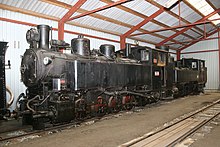BBÖ Kh
| BBÖ Kh / StLB Kh / ÖBB 499 | |
|---|---|
|
Kh.101 of the Feistritztalbahn after general inspection in the workshop of the Zillertalbahn in Jenbach station (2013)
|
|
| Numbering: | BBÖ Kh.1, StLB Kh.101, Kh.111, ÖBB 499.01 |
| Number: | BBÖ: 1 StLB: 2 ÖBB: 1 |
| Manufacturer: | Krauss / Linz |
| Year of construction (s): | 1924 |
| Retirement: | 1973 (ÖBB) |
| Axis formula : | Eh2t |
| Gauge : | 760 mm ( Bosnian gauge ) |
| Length over coupling: | 8.720 m |
| Total wheelbase: | 4,150 mm |
| Service mass: | 33.3 t |
| Friction mass: | 33.3 t |
| Top speed: | 25 km / h |
| Driving wheel diameter: | 820 mm |
| Control type : | Heusinger control, Caprotti valve control |
| Number of cylinders: | 2 |
| Cylinder diameter: | 400 mm |
| Piston stroke: | 400 mm |
| Boiler overpressure: | 12.0 atm |
| Number of heating pipes: | 26/40 |
| Heating pipe length: | 3,800 mm |
| Grate area: | 1.21 m² |
| Radiant heating surface: | 4.85 m² (in contact with fire) |
| Tubular heating surface: | 45.35 m² (in contact with fire) |
| Evaporation heating surface: | 50.2 m² (in contact with fire) |
| Water supply: | 3.5 m³ |
| Fuel supply: | 1.32 t |
The steam locomotive series Kh was a narrow gauge - Tender Locomotive series of BBÖ which was procured for private local railways in Styria.
history

After the First World War, the Kühnsdorf - Eisenkappel ( Vellachtalbahn ) local railway in Carinthia only had one locomotive, the T .5, later BBÖ T.4 "(second occupation). The Austrian Federal Railways therefore ordered a more powerful machine from Krauss in Linz , which was also used for the planned dolly transport was needed, the ten-coupled. superheated steam -Lokomotive was delivered in 1924, since the five-couplers had to ride on the Vellachtalbahn radius of 60 meters, a special construction was chosen the chassis. the first four of their axes are in an internal frame, the fifth in an outer frame as Klien-Lindner axle running stored. the first dome axis is also performed laterally displaceable. the designation of the number touched by the initial letters of the place Kühndorf ago, the "h" stands for superheated steam.
In 1926 a similar machine was delivered for the Murtalbahn (Kh.101), in 1930 one for the Feistritztalbahn from Birkfeld to Ratten (Kh.111). After the private railway companies were dissolved, both machines were transferred to the Styrian State Railways as their successors.
Technically, all three machines are individual pieces that differ in the type of control: While the Kh.1 was equipped with the Lentz valve control that was common at the BBÖ for new acquisitions , the Kh.101 received a normal Heusinger control with piston valves. The Caprotti valve control, which is rare in Austria, was used for the Kh.111.
In 1938 the Deutsche Reichsbahn classified the BBÖ machine as 99 1201, in 1953 the ÖBB as 499.01 . It was always at home on its regular route and was retired in 1973. Today it is not operational in the vehicle collection of the Gurktalbahn .
The StLB Kh.101 will continue to be maintained as an active operating machine for the tourist trains on the Feistritztalbahn, the Kh.111 belongs to the Club 760 and is in the vehicle hall of the club in Frojach on the Murtalbahn not operational.
literature
- 300 HP E-hot steam twin tank locomotive, 760 mm gauge, for the Kühnsdorf – Eisenkappel local railway. In: Die Lokomotive , year 1924, No. 11 (November) / 1924 (XXI. Year), p. 168 f. (Online at ANNO ).
- Walter Krobot, Josef-Otto Slezak, Hans Sternhart: Schmalspurig durch Österreich 1825–1975 , 4th edition, Slezak publishing house, Vienna 1991, ISBN 3-85416-095-X
- Heribert Schröpfer: Traction vehicles of Austrian railways - steam locomotives BBÖ and ÖBB , alba, Düsseldorf, 2nd edition 2002, ISBN 3-87094-185-5

